Introduction
To prove that a display technology introduces artifacts, all of the following must be proved ...
- That no artifact exists in the original source video;
- And that it only appears on the one type of display;
- And that there are no other differences between the displays that could cause the same effect;
- And, for an artifact to be caused by motion, it mustn't be present when the source stream is paused;
- And it must be shown that an artifact actually exists, for example by capturing it with a high speed camera shooting the display showing the artifact over its lifetime.
As a counter example, this experiment demonstrates photographically that when a source video is paused, the poorer definition of this CRT compared with this LCD, that might be expected from its inferior effective resolution, is almost certainly sufficient to explain all the differences between them when the video is running at normal speed.
That is, it showed that in practice on these TVs condition 3 above is never likely to be met, so 4 & 5 become of marginal importance.
Results
A 900 x 700 (camera) pixel fragment of an Alpine scene with a piste ...
The edges of picture detail are much more blurred on the CRT, strikingly so where blue is involved, though
where reds are concerned, this picture suggests that the CRT has a slight advantage. On noticing the latter
in the photos, I cued up the shot again, putting the LCD's Backlight and Brightness back to normal, and to
the eye the difference decreased, but the reds on the CRT still remained slightly better. However, the LCD
has such a clear advantage with blues that it is this difference which greatly predominates both in this
scene and in normal viewing.
If you examine closely the 'busy' area bottom middle left to middle right inside the curve of the piste -
an advertisement banner, safety netting, flags, etc - most of this detail, particularly vertical edge
detail such as the line of flags disappearing out of shot back up the slope, as well as the detail above
them at the edge of the trees, is significantly less clear on the CRT.
| CRT |
|---|
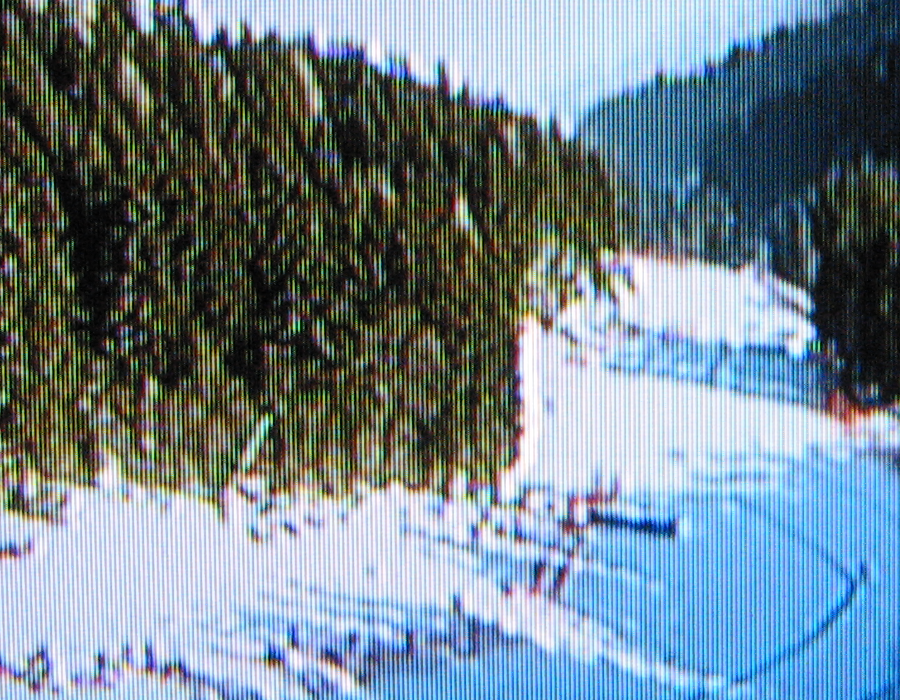 |
| LCD |
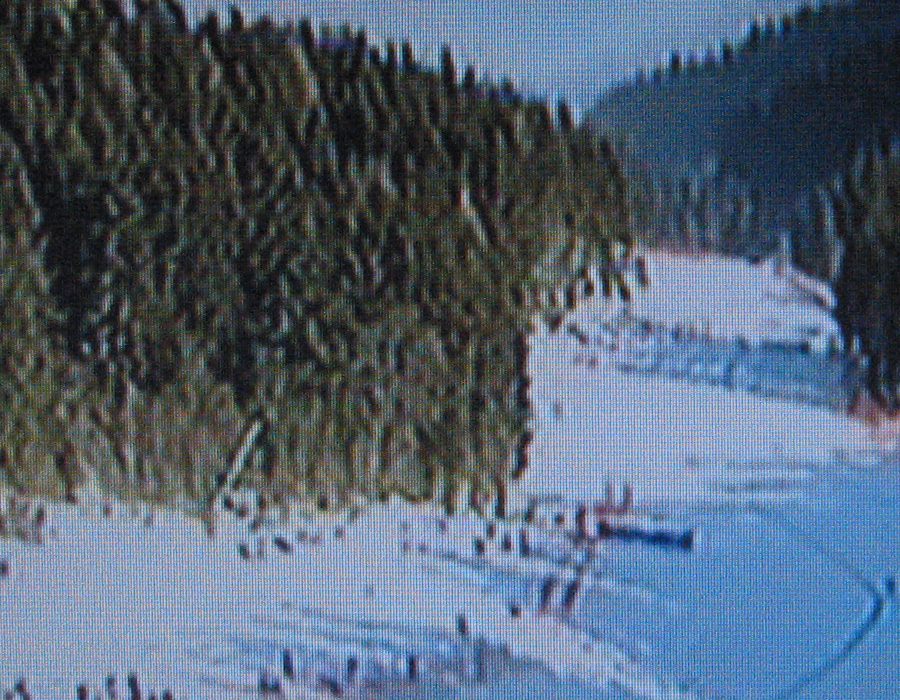 |
A 500 x 300 (camera) pixel fragment of a distant peak ...
The loss of detail in the CRT picture is also very noticeable here.
While one's first reaction to the pictures may be that the CRT is better because of the darkness of the LCD
picture, that is how the camera, not the human eye, sees the scenes. To the human eye, the televisions
don't actually appear very different in brightness, and what is noticeable is the loss of detail on the CRT.
There are compression artifacts appearing as 'fraying' or 'tearing' of the left-hand ridge descending from
the peak. In the pictures they are only slightly more pronounced on the LCD, but in real life they
are obvious on the LCD and barely visible on the CRT.
But there's more here, that you don't have to take my word for. If you examine the sunlit surfaces of the
peak, you will realise that two details, a round shape on the farther surface and a thin shadow caused by
a slight ridge on the nearer, together with the ruggedness of the terrain to the left of this thin shadow,
have all been almost completely lost on the CRT.
| CRT | LCD |
|---|---|
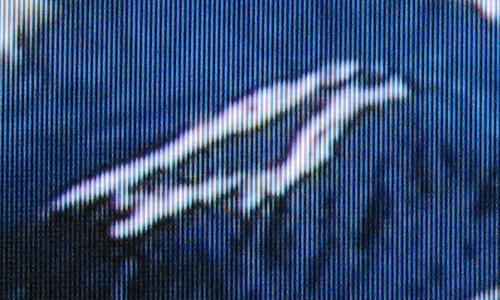 |
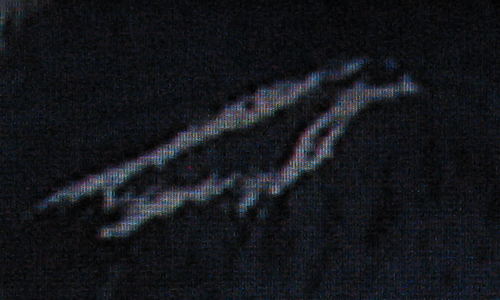 |
A 300 x 200 (camera) pixel fragment of a distant peak ...
Here the CRT is again swallowing compression artifacts ...
To the left of the table-top peak on the LCD there are faint lighter blotches, one being more noticeable
than the rest, but once you get your eye in there are at least three others. These are part of a much
larger 'fly-swarm' of compression artifacts buzzing around the entire peak. The swarm is very
noticeable on a bigger LCD, quite noticeable on this LCD, but almost indistinguishable on this CRT.
In fact, on the CRT, if you didn't already know it was there you almost certainly wouldn't spot it.
You can see why when you compare the pictures.
| CRT | LCD |
|---|---|
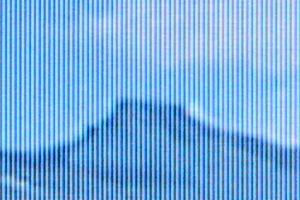 |
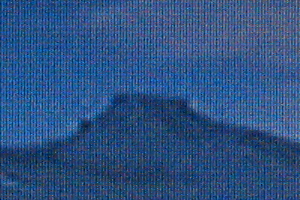 |
Conclusion
While one cannot say for certain that this LCD produces no artifacts, the facts that ...
- All artifacts ever investigated on it by recuing the source programme and pausing the replay have shown the artifacts to be in the source video stream
- As demonstrated here, so much significant detail is lost by this CRT TV
... taken together are adequate to explain why more artifacts appear on this LCD compared with this CRT.
In plain English, the LCD shows more artifacts because it displays the source material more faithfully, including any artifacts in it.
Equipment
Please see the description in CRT vs LCD.
Experimental Procedure
Because of the difficulties in obtaining adequate exposures for the LCD, only very bright source material could be used, which I have found to be the material where by and large there is least difference between the televisions, so I believe these results are approximately a 'best case scenario' for the CRT ('worst case' would probably be seascapes, but on the LCD these give an inadequate exposure to be photographed).
The signal source was a UK Digital Terrestrial Television (UK DTT, aka 'Freeview') recording of Channel 4's 'World Cup Skiing' broadcast on Tuesday 8th January 2008 at 0210, made by a Pace Twin Freeview Hard Disk recorder, with the playback paused.
Under experimental conditions, the camera rated the exposure for the CRT as -2/3 (-0.67) to -1 1/3 (-1.3) 'stops', and the LCD at very best as -1 2/3 (-1.67) 'stops'.
Focusing was done manually by zooming in to maximum, adjusting the focus, and then zooming out to minimum.
All shots were taken at minimum zoom to ensure the zoom was the same for both TVs.